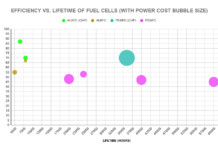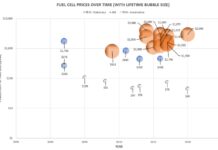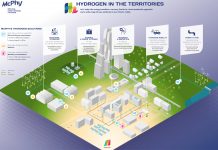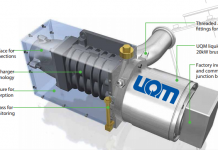by Lee Shane
When one thinks of fuel cells and fuel cell technology some names immediately come to mind. Ballard Power (BLDP) went public in 1993 and was listed on NASDAQ in 1995. A company that made its debut in 1997 was Plug Power (PLUG), a joint venture between DTE Energy and Mechanical Technology Inc. Hydrogenics (HYGS) is a company that has been around for 60 years, but more recently has gotten investor attention for their fuel cell technology.
Most of the technology produced by well-known fuel cell companies share common features…
- They are based on fuel cell technology that requires hydrogen gas or a reformer that makes H2 out of the fossil fuel feed. They use a very expensive, very rare catalyst, Platinum.
- Portable fuel cells are based on fuel cell technology that requires a PEM, Proton Exchange polymer Membrane
- They have all enjoyed various levels of success, but the existing technology appears to be limited to heavy vehicles (buses / forklifts) and backup power systems for specific applications.
The reality is that most of the existing fuel cell technology has never really reached the level of portability once imagined for fuel cells.
However one new entrant in the fuel cell sector may be capable of regenerating some of the early initial excitement. They have eliminated the Achilles heel, the PEM membrane, the bipolar plates, and the platinum catalyst…
That company is Mantra Energy Alternatives (MVTG) based out of British Columbia.
Recently MVTG has revealed their patented MRFC fuel cell. It is a “membrane-less” and “platinum-free” ultra-low cost fuel cell that appears to be totally unique in the market. As mentioned previously, the PEM membrane, the bi-polar plates, and the precious metals catalyst are among the most expensive and heavy parts of any fuel cell. The PEM Membrane is also one of the degrading components of PEM fuel cells, so the MVTG MRFC fuel cell is expected to have a much longer operating life, because there is no membrane to degrade. MVTG claims to have eliminated about 2/3rds of the cost of a typical PEM style fuel cell.

We know the significant infrastructure challenges hydrogen gas still presents for widespread commercial deployment. It was recently reported that even now there may be less than 15 commercially accessible hydrogen fueling stations available in the U.S. But the MVTG-MRFC fuel cell does not require hydrogen gas. MVTG has eliminated the need for H2 gas feed in their MRFC fuel cells, and instead uses non-flamable liquid formates and formic acid as fuel. It is the H proton bonded to the back bone of a CO2-molecule (which is formic acid) that is the hydrogen fuel that the MVTG-MRFC fuel cell uses, and in that state, formate-formic acid, it is non-flammable, and is stored at ambient pressure and temperature. The MVTG fuel cell also does not require an expensive, energy consuming, bulky, and heavy reformer like other fuel cells use to handle direct fossil fuel feeds.

The technology is the result of an impressive R&D collaboration from multiple Universities located in Canada, Japan, and the U.S. The potential of this new fuel cell technology makes it worthy of acknowledgment.
Lee Shane works in information technology for a Fortune 500 company, and is an individual investor with over 20 years experience. His focus is on small to mid size technology companies that have the potential to be disruptive, or offer benefits to the sectors they are targeting that legacy technology may not currently provide. He has a strong interest in green building concepts and alternative energy and looks for hands-on opportunities in those areas







